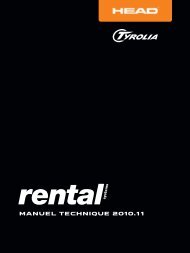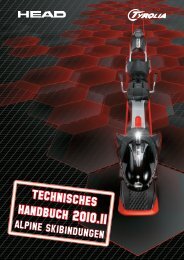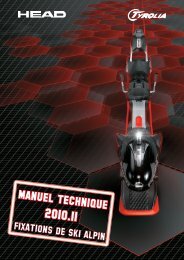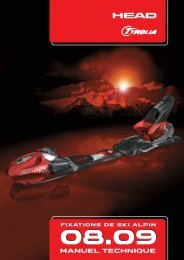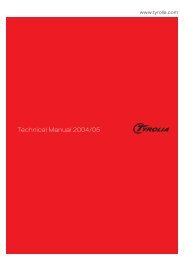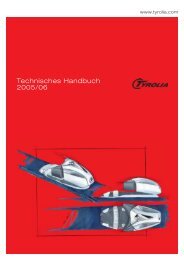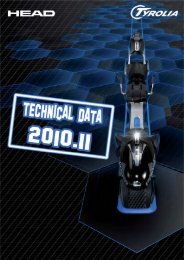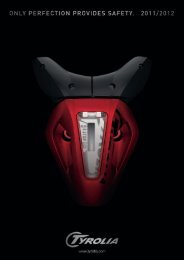You also want an ePaper? Increase the reach of your titles
YUMPU automatically turns print PDFs into web optimized ePapers that Google loves.
50 / RENTAL<br />
15. If many bindings fail, check the test device<br />
and re-inspect the Reference Boot.<br />
If necessary, select another boot and retest<br />
the bindings.<br />
F<br />
Skier Code<br />
Binding<br />
Type<br />
Children<br />
Sole<br />
length<br />
mm<br />
Release<br />
Indicator<br />
J Junior 3<strong>06</strong> mm 4.5 45 Nm 175 Nm<br />
L Adult 327 mm 6.0 60 Nm 239 Nm 51–69 Nm 203–275 Nm<br />
Preseason Boot Preparation<br />
The procedure that follows is an integral part of<br />
preseason maintenance.<br />
1. Clean all boots with a mild detergent and water,<br />
and repair or replace damaged or missing<br />
parts.<br />
2. Visually check:<br />
a.) Conformance with ISO and other applicable<br />
standards- ISO 5355. If the boot contacts<br />
the binding, brake, or AFD in areas other<br />
than the designated contact points, it may<br />
be incompatible with the binding.<br />
b.) Boot material. If the sole at the contact<br />
points with the binding or AFD can be<br />
scratched with a finger nail, the boot may<br />
be of inferiors quality and incompatible<br />
with the binding.<br />
c.) Boot sole condition. If the boot sole is<br />
damaged, worn, or contaminated at<br />
contact points with the binding or AFD in<br />
a manner which can not be corrected, the<br />
boot may be incompatible with the binding,<br />
“Verify boot sole dimensions” on page 53.<br />
d.) Brake compatibility with sole.<br />
e.) Rubber and/or metal sole protectors.<br />
If such materials contact the binding or<br />
AFD the boot may be incompatible with<br />
the binding.<br />
f.) Mold flashings. Flashing which can be.seen<br />
or felt at contact points with the binding,<br />
brake, or AFD must be carefully removed.<br />
3. Remove from inventory all boots that have<br />
failed the visual check.<br />
Preseason Boot Sampling<br />
Although sampling eliminates the need to test<br />
every boot before the season starts, the sample<br />
chosen must be representative of the inventory.<br />
1. For boots that are new to inventory or have 1.<br />
never been inspected, take a single boot from<br />
each cell (a cell is all boots of the same make,<br />
model, year, and shell size).<br />
Setting<br />
Reference<br />
Torque<br />
Twist Nm<br />
Reference<br />
Torque<br />
270mm 2.5 25 Nm 94 Nm 21–29 Nm 80–108 Nm 17.5–33 Nm<br />
Forward Nm<br />
Twist<br />
Inspection<br />
Range Nm<br />
Forward<br />
Inspection<br />
Range Nm<br />
38–52 Nm 149–201 Nm<br />
Table [A] Preseason Binding Inspection<br />
Twist In-<br />
Use Range<br />
31–59 Nm<br />
42–78 Nm<br />
Forward In-<br />
Use Range<br />
Nm<br />
66–122Nm<br />
122–228 Nm<br />
167–311 Nm<br />
2. For used boots, take a 5% (but not less than<br />
16 or more than 80) random sample of the<br />
entire inventory, see Table [B]. Make sure<br />
that there is at least one boot from each cell<br />
in the sample.<br />
Preseason Boot Inspection<br />
The procedure that follows helps to assure boot/<br />
binding compatibility and boot interchange ability.<br />
Note: when using Table [A], in the Boot Inspection<br />
procedures that follow, the Sole Length and release<br />
Indicator Setting columns should be ignored.<br />
1. Randomly select a pair of bindings that have<br />
passed the preseason inspection from each<br />
binding type; adult, junior, child.<br />
2. Lubricate all boot/binding contact points with<br />
a mild liquid detergent.<br />
3. Without regard to whether the boot is new or<br />
used, sort the sample by sole type and length<br />
according to the 20 mm Sole Length Categories<br />
defined by the Release/Retention<br />
Adjustment Chart.<br />
4. In each Sole Length Category rank the boots<br />
by sole length and select the middle boot.<br />
5. In each Sole Length Category fit the appropriate<br />
reference bindings to this “typical” boot<br />
and adjust the two bindings to release as<br />
close as practical to the Reference Torque in<br />
Table [A]. Use the Reference Torque corresponding<br />
to Skier Code [L] for the6 Adult<br />
binding, [J] for Junior binding, and [E] for the<br />
Child binding.<br />
6. Rinse the lubricant from one binding and<br />
mark it “clean”. Mark the other “lubricated”.<br />
7. Test each boot in the Sole Length Category<br />
with the clean Reference Binding and then<br />
the lubricated Reference Binding in both twist<br />
and forward lean (only one direction in twist is<br />
required for the clean binding).<br />
8. Set aside any boots for which the lubricated<br />
Test Result is more than 20% less than the<br />
clean Test Result in the same direction of<br />
release or the lubricated Test Result in any



